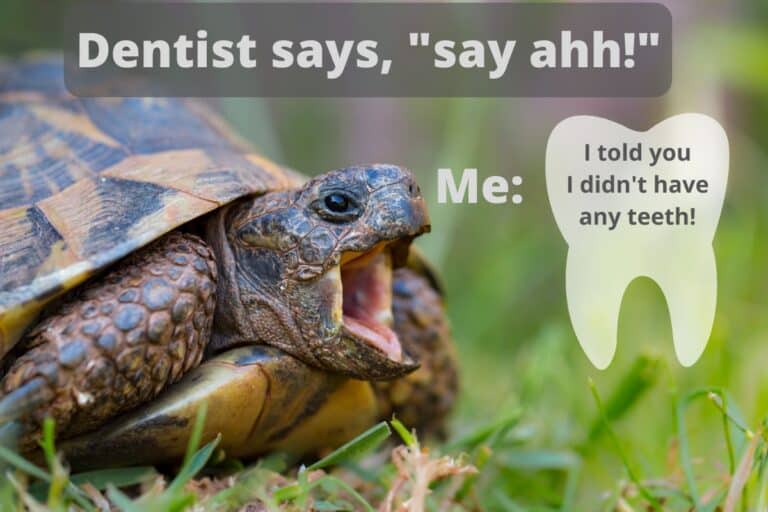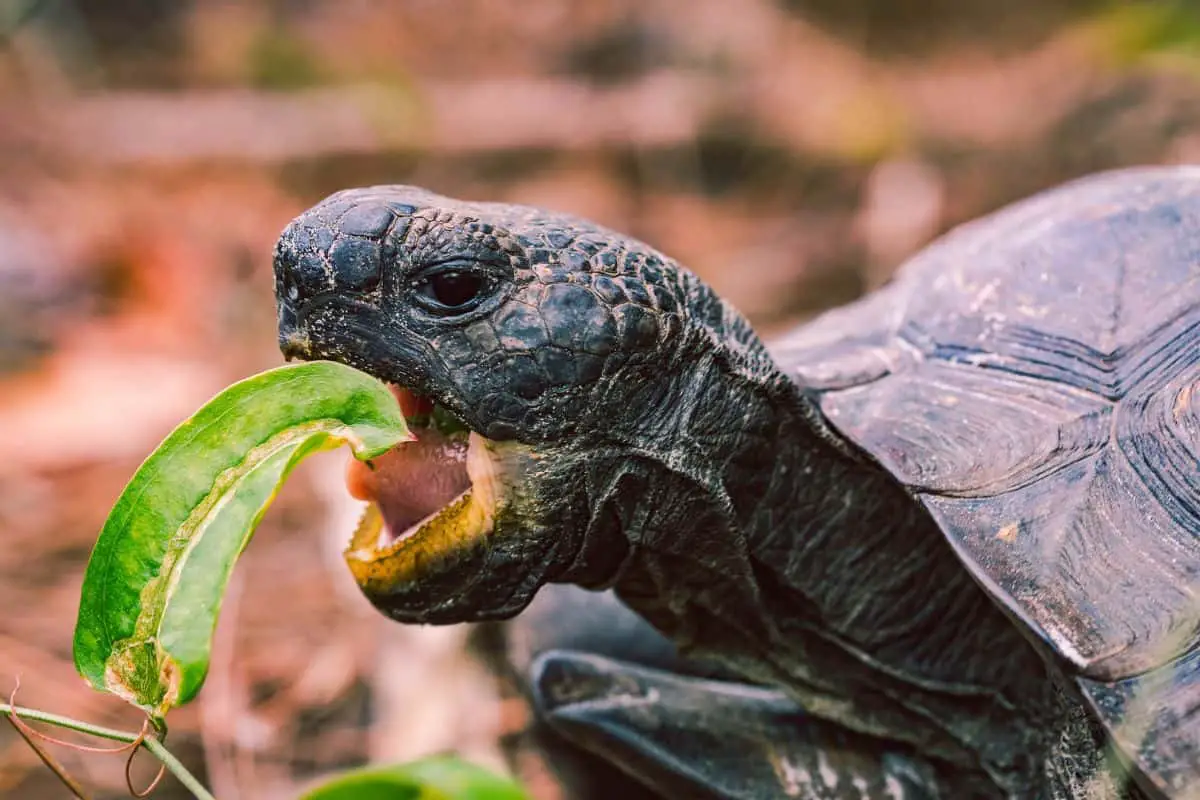Do Turtles and Tortoises Have Teeth Or Beaks?
Turtles and tortoises have more in common with birds than they do with other reptiles! (at least when it comes to their teeth or lack of them!)
Turtles and tortoises do not have teeth, instead they have beaks!
Reptile Roommate is a participant in the Amazon Services LLC Associates Program. As an Amazon Associate I earn from qualifying purchases.
Tortoise and Turtle Teeth
Even though we just learned that turtles and tortoises don’t have teeth, hatchlings do in fact have what is referred to as an egg “tooth” on their beak that helps them to break free of their shell. This tooth is lost soon after hatching.

Tortoise and Turtle Beaks
Turtles and tortoises eat loads of vegetables and even meat (depending on species) and you may be wondering how they consume their meals if they don’t have any teeth?!
Turtles and tortoises don’t need teeth because of their specialized beaks which they use to chomp, crunch, bite and grab all manner of vegetation and prey.
Plant matter, fruits and vegetables, as well as insects, fish, worms, crustaceans, and in the case of large predatory turtles, small mammals, frogs, snakes, fish (jelly fish for sea turtles) and even other turtles are all potential sources of nutrition!
A turtle’s beak keeps growing much the same way that our fingernails keep growing and so they do need to eat food that will wear down their beaks to keep them from overgrowing.
Tortoises and turtles beaks are kind of amazing, who needs teeth?!!
Do Turtles Bite? Can a Tortoise Bite you?
Turtles and tortoises may not have teeth but that doesn’t mean that they can’t bite you!
A small to medium size turtle can bite you and not much harm may come except for perhaps a painful pinch!
Large turtles and tortoises however, can inflict very painful and damaging bites!
Turtle and tortoise beaks can be quite sharp and surprisingly even small turtle bites can break the skin.
Do Turtle Bites Hurt?
Turtle bites can be quite painful, even from a small turtle such as a red eared slider! Just because your turtle or tortoise is small doesn’t mean that it won’t hurt if bites you!
Larger turtles, like snapping turtles, have even more powerful bites that you will definitely feel and they like to hold on for dear life and are reluctant to let go! Ouch!!
…and you definitely do not want to be bitten by a large alligator snapping turtle!
These large turtles have very powerful jaws, that power, coupled with large, sharp beaks can cause considerable damage!
As scary and painful as an alligator snapping turtle bite can be, most turtle enthusiasts do not keep these species.
The most commonly pet turtle and tortoise species cannot do the damage and inflict the pain that a large snapping turtle can, however they can bite and it can (really) hurt!
What happens with your pet turtle then, do you have to be wary of their beak or can you even file or trim it to make it less painful..?
Do You Have to Trim Tortoise Beaks?
In the wild most turtles and tortoises are constantly foraging and hunting for food which provides them ample opportunities to wear down their beaks with all the chewing, grabbing, and crunching going on.
In captivity however, if your turtle lacks an adequate, varied diet it can develop issues by not being able to wear down its continuously growing beak.
This overgrowth will only worsen over time and will eventually hinder eating and can even prevent the turtle from pulling its head into its shell!
Improper husbandry, including providing food options that are too soft, not having enough wood and stones for the turtle (tortoise) to wear its beak against and lack of UVB light and calcium can all contribute to an overgrown beak.
The best thing to do for an overgrown beak is to try and prevent it in the first place however that’s not always the case or possible.
In the event you turtle or tortoise does have an overgrown beak, it can be trimmed.
Can You File a Tortoise Beak?
One of the ways that you can keep a tortoise’s beak in good shape is to file it as it starts to get a bit long or overgrown. Filing can be accomplished with a nail file or emery board that you would use on your fingernails.
Filing is one of the safest methods and least likely to make a mistake or remove too much. Because of this filing is much too labor intensive and stressful for the animal if its beak is very large or severely overgrown.
Filing tortoise beaks that are just slightly overgrown can keep from having more severe issues later on down the road.
Tortoise Beak Trim
Tortoises or turtles that have very overgrown beaks or are just larger animals in general will need more effective methods of removing the overgrowth.
Cuticle nail cutters, or even a dremel tool for large tortoises, can work wonders in maintaining a healthy and properly proportioned beak.
Filing, cutting and trimming your tortoise’s beak may seem like a daunting task and for many a visit to your local veterinarian is the best choice when faced with an overgrown beak.
Your veterinarian will help maintain proper beak length and also guide you in performing the procedure yourself if you are up for the task.
Like with any trimming or cutting, even outside of turtle health care, going slow, bit-by-bit will help ensure that you don’t remove too much of your turtle’s beak at once.
Trim small bits away slowly, checking for evenness and making sure to file down any areas that have been trimmed so that they are not too sharp or have jagged edges.
Filing and clipping a tortoise’s beak is very similar to clipping your own nails if they were a bit thicker and somewhat more brittle.
Sloooow, is the key!
Broken Tortoise Beak; Do Tortoise Beaks Grow Back?
A tortoise’s beak does grow back!
In any situation where a turtle or tortoise has a broken beak or when a piece of the tortoise’s beak breaks off, they should be seen by a veterinarian.
The reason for this is that while their beaks do continually grow, if there is damage to the bone underneath or there is an underlying cause like MBD (metabolic bone disease), calcium deficiency or improper amounts of UVB light, beak growth could be hindered and/or regrow misshapen.
Tortoise Beak Rot; Mouth Rot
Another potential problem for turtle and tortoise beaks is stomatitis or mouth (beak) rot. Stomatitis is a general term for an infection in the mouth and as such can have a number of causes.
Generally mouth rot in turtles and tortoises is caused by bacteria which is present in the tortoise’s mouth. Normally this bacteria doesn’t cause the turtle any harm, however when an injury or other stress (punctures while eating or ill health) is present the bacteria can cause infection.
Left untreated, this infection can quickly accelerate into mouth rot. Loss of tissue and bone can result from cases of mouth rot which in turn will negatively affect your tortoise’s ability to eat.
Mouth rot, or suspected mouth rot, needs to be evaluated by a veterinarian because of the seriousness of the situation. In most cases an antiseptic wash or antibiotic cream will be applied as treatment. (1)
Do Turtles Have Teeth? No, They Don’t!
Turtles do not have teeth, instead they have beaks! Beaks that would impress even the most discerning parrot!
Turtles and tortoises don’t need teeth when they have such impressive, continuously growing beaks!


